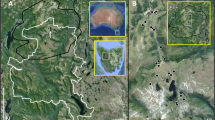Abstract
A simple Markov model is used to test the hypothesis that the floristic composition of vegetation colonizing bare ground immediately after burning is the major factor influencing post-fire development in heathland vegetation. Data are taken from stands of different ages at time of burning in a species-rich Calluna-Arctostaphylos heath in NE Scotland. It is shown that variation in the initial floristic composition of the stands is not, in itself, sufficient to produce model simulations which match observed trends, although altering the probabilities of transition from bare ground to other states allows more successful simulations. The model supports the hypothesis that stand age before burning influences the post-fire development through the process of colonization of bare ground. After a very severe fire post-fire development may initially depend on the formation of a moss cover, although this requires further study. It is concluded that simple Markov models can provide the basis for examining successional processes when used in a comparative way.
Similar content being viewed by others
References
Austin, M. P. & Belbin, L., 1981. An analysis of lawn succession along an environmental gradient using data from a lawn. Vegetatio 46: 19–30.
Bellefleur, P., 1981. Markov models of forest-type secondary succession in British Columbia. Can. J. For. Res. 11: 18–29.
Gimingham, C. H., 1972. Ecology of Heathlands. Chapman & Hall, London. 266 pp.
Gimingham, C. H., Hobbs, R. J. & Mallik, A. U., 1981. Community dynamics in relation to management of heathland vegetation in Scotland. Vegetatio 46: 149–155.
Hobbs, R. J., 1981. Post-fire succession in heathland communities. Unpubl. Ph.D. Thesis, University of Aberdeen, Scotland. 371 pp.
Hobbs, R. J., 1983. Markov models in the study of post-fire succession in heathland communities. Vegetatio 56: 17–30.
Hobbs, R. J. & Gimingham, C. H., 1984. Studies on fire in heathland communities in Scotland II. Post-fire vegetation development J. Ecol. (in press).
Horn, H. S., 1975. Markovian properties of forest succession. In: M. L., Cody & J. M., Diamond (eds.). Ecology and Evolution of Communities, pp. 196–211. Belknap, Harvard Univ. Press, Cambridge, Mass.
Hulst, R.van, 1979. On the dynamics of vegetation: Markov chains as models of succession. Vegetatio 40: 3–14.
Hulst, R.van, 1980. Vegetation dynamics or ecosystem dynamics. Dynamic sufficiency in succession theory. Vegetatio 43: 147–151.
Kemeny, J. G. & Snell, J. L., 1967. Finite Markov Chains. D. van Nostrand, Princeton, New Jersey. 210 pp.
Kullback, S., Kupperman, M. & Ku, H. H., 1962. Tests for contingency tables and Markov chains. Technometrics 4: 572–608.
Legg, C. J., 1978. Succession and homeostasis in heathland vegetation. Unpubl. Ph.D. Thesis, University of Aberdeen, Scotland. 219 pp.
Legg, C. J., 1980. A Markovian approach to the study of heath vegetation dynamics. Bull. Ecol. 11: 393–404.
Mallik, A. U. & Gimingham, C. H., 1983. Regeneration of heathland plants following burning. Vegetatio 53: 45–58.
Mallik, A. U., Hobbs, R. J. & Legg, C. J., 1984. Seed dynamics in Calluna-Arctostaphylos heath in Scotland. J. Ecol (in press).
McIntosh, R. P., 1980. The relationship between succession and the recovery process in ecosystems. In: J., Cairns (ed.). The Recovery Process in Damaged Ecosystems, pp. 11–62. Ann Arbor Science Publ., Ann Arbor, Michigan.
Miller, G. R. & Miles, J., 1970. Regeneration of heather (Calluna vulgaris (L.) Hull) at different ages and seasons in northeast Scotland. J. Appl. Ecol. 7: 51–60.
Mohamed, B. F. & Gimingham, C. H., 1970. The morphology of vegetative regeneration in Calluna vulgaris. New Phytol. 69: 743–750.
Noble, I. R. & Slatyer, R. O., 1981. Concepts and models of succession in vascular plant communities subject to recurrent fire. In: A. M., Gill, R. O., Groves & I. R., Noble (eds.). Fire and the Australian Biota, pp. 319–335. Australian Academy of Science, Canberra.
Purdie, R. W. & Slatyer, R. O., 1976. Vegetation succession after fire in sclerophyll woodland communities in southeastern Australia. Aust. J. Ecol. 1: 223–236.
Smith, A. J. E., 1978. The Moss Flora of Britain and Ireland. Cambridge University Press, London. 706 pp.
Tutin, T. G., Heywood, V. H., Burges, N. A., Valentine, D. H., Walters, S. M. & Webb, D. A., 1964–80. Flora Europaea, Vols. I–V. Cambridge University Press, London.
Usher, M. B., 1981. Modelling ecological succession, with particular reference to Markovian models. Vegetatio 46: 11–18.
Watt, A. S., 1955. Bracken versus heather, a study in plant sociology. J. Ecol. 43: 490–506.
Author information
Authors and Affiliations
Additional information
Nomenclature follows Tutin et al. (1964–80) for vascular plants and Smith (1978) for mosses.
We thank Prof. C. H. Gimingham for comments on the draft, and J. M. M. Humphrey, P. Marren and the Nature Conservancy Council for permission to work on the Muir of Dinnet.
Rights and permissions
About this article
Cite this article
Hobbs, R.J., Legg, C.J. Markov models and initial floristic composition in heathland vegetation dynamics. Vegetatio 56, 31–43 (1984). https://doi.org/10.1007/BF00036134
Accepted:
Issue Date:
DOI: https://doi.org/10.1007/BF00036134




